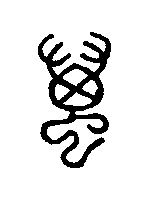LTBA Volume 18.2
FROM THE EDITOR
This issue is devoted entirely to an
extraordinary monograph by Richard S. Cook, Jr., on the etymology
of Mandarin chén, the fifth of the twelve "earthly branches"
among the Chinese zodiacal symbols. Joining an impressive command
of the Chinese philological and graphological tradition to a
familiarity with matters astronomical and arachnological, Cook
succeeds in demonstrating that chén actually represents a
scorpion ready to strike, and is to be identified with the first
magnitude red giant star Antares in the "breast" of the
constellation Scorpio.
The monograph is interesting from many
points of view, offering insight into such diverse matters as the
traditional componential analysis of Chinese characters in the
Shuowen, the connections between Chinese astronomical notions and
those of the ancient Middle East, and the cultural associations of
the scorpion in the Chinese worldview. The final section (# 12),
admittedly the most speculative, undertakes a preliminary
comparison of Chinese etyma related to 'scorpion' with those that
can be reconstructed from Tibeto-Burman languages.
The erudition of the author is everywhere
apparent, not least in the extensive apparatus of notes.
Typographically, this is the most complex document ever published
in LTBA. Produced entirely from the author's camera-ready copy, it
includes small-seal, bronze, and oracle-bone Chinese characters, as
well as Sumerographs, Cyrillic, Greek, and Arabic fonts, starmaps,
and a variety of other illustrations and tables.
Exhaustive as it is, this monograph is
conceived of as only the first part of a much larger work covering
all 22 of the calendrical signs of the Sexagesimal Cycle of
Heavenly Stems and Earthly Branches (tiangandizhi). LTBA is pleased
to help get this project off to its celestial start.
James
A. Matisoff
Berkeley, January 1997
* * * *
*
|


